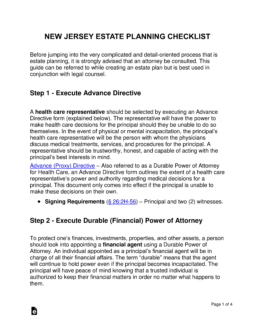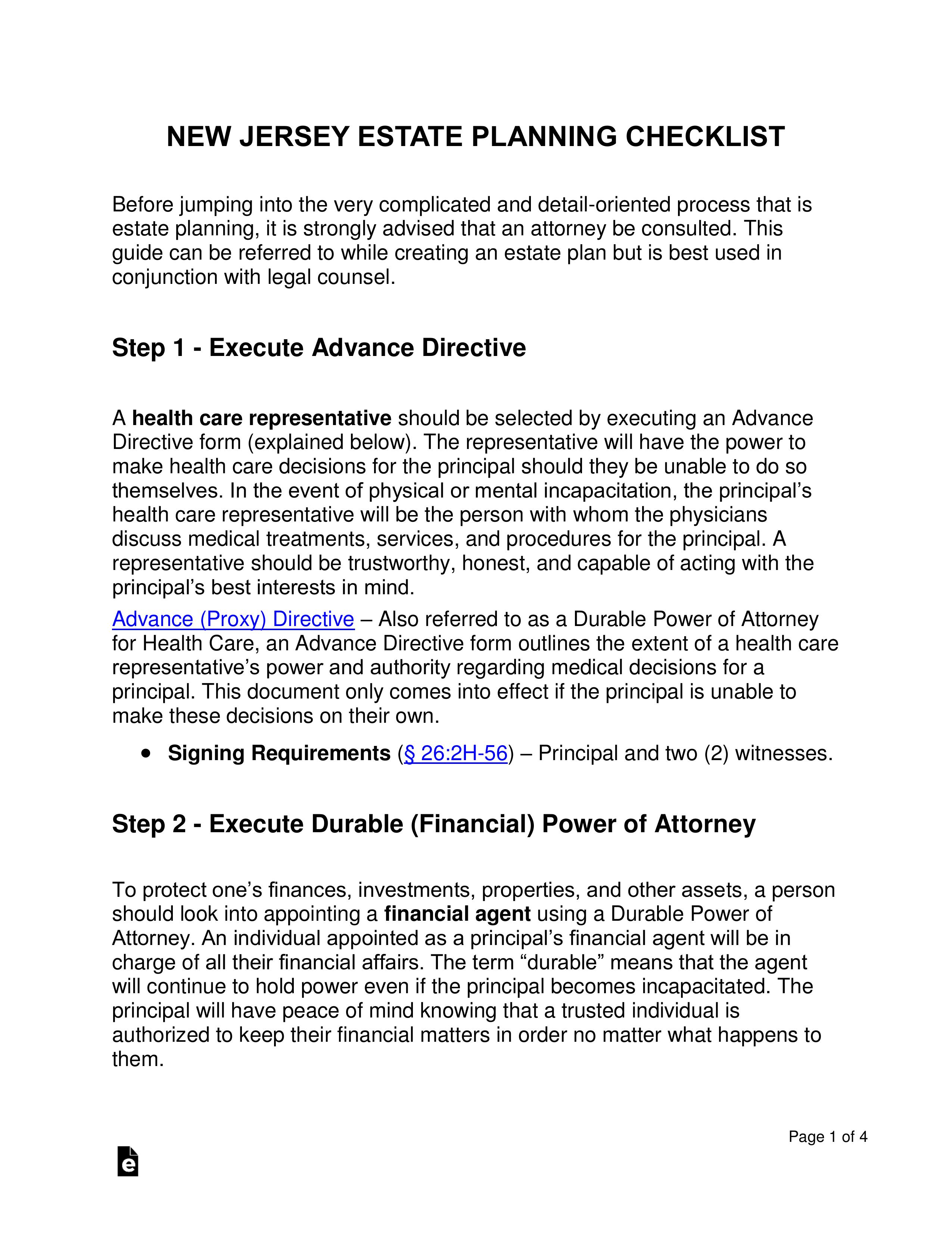Updated March 05, 2024
A New Jersey estate planning checklist is an instrument that can help an individual keep organized while planning for their death or for an unexpected accident or illness. The estate planning documents mentioned in this article cover an individual’s needs in regard to medical decisions, financial affairs, distribution of their estate and other assets, guardianship, and debt arrangements. For a person to gain peace of mind, executing the following documents will be extremely valuable: Advance Directive (medical), Durable Power of Attorney (financial), Last Will and Testament (estate distribution, guardianship, debt arrangements), and a (Revocable) Living Trust (private estate distribution).
How to Create an Estate Plan in New Jersey (6 steps)
- Execute Advance Directive
- Execute Durable (Financial) Power of Attorney
- Compile List of Assets
- Select Beneficiaries
- Execute Primary Estate Planning Instrument
- Safely Store Documents
Before jumping into the very complicated and detail-oriented process that is estate planning, it is strongly advised that an attorney be consulted. This guide can be referred to while creating an estate plan but is best used in conjunction with legal counsel.
1. Execute Advance Directive
A health care representative should be selected by executing an Advance Directive form (explained below). The representative will have the power to make health care decisions for the principal should they be unable to do so themselves. In the event of physical or mental incapacitation, the principal’s health care representative will be the person with whom the physicians discuss medical treatments, services, and procedures for the principal. A representative should be trustworthy, honest, and capable of acting with the principal’s best interests in mind.
Advance (Proxy) Directive – Also referred to as a Durable Power of Attorney for Health Care, an Advance Directive form outlines the extent of a health care representative’s power and authority regarding medical decisions for a principal. This document only comes into effect if the principal is unable to make these decisions on their own.
- Signing Requirements – Principal and two (2) witnesses.[1]
2. Execute Durable (Financial) Power of Attorney
To protect one’s finances, investments, properties, and other assets, a person should look into appointing a financial agent using a Durable Power of Attorney. An individual appointed as a principal’s financial agent will be in charge of all of their financial affairs. The term “Durable” means that the agent will continue to hold power even if the principal becomes incapacitated. The principal will have peace of mind knowing that a trusted individual is authorized to keep their financial matters in order no matter what happens to them.
Durable (Financial) Power of Attorney – This legal instrument appoints a financial agent to handle a principal’s financial matters and details which powers the agent is permitted to exercise.
- Signing Requirements – Must be signed by the principal and acknowledged in the manner prescribed by § 46:14-2.1.[2]
Financial Powers Allowed:
- Real property transactions;
- Tangible personal property transactions;
- Stock and bond transactions;
- Commodity and option transactions;
- Banking and other financial institution transactions;
- Business operating transactions;
- Insurance and annuity transactions;
- Estate, trust, and other beneficiary transactions;
- Claims and litigation;
- Personal and family maintenance;
- Benefits from governmental programs or military service;
- Retirement plan transactions; and
- Tax matters.
3. Compile List of Assets
4. Select Beneficiaries
5. Execute Primary Estate Planning Instrument
At this juncture, a person must consider which document is better suited to their needs; a Last Will and Testament or a Living Trust. Since these instruments are quite different, it is possible that the principal will want to implement both. The ultimate objective is to have specific instructions written out for a representative to distribute the principal’s estate to the intended beneficiaries without overlooking any assets. Any portion of the principal’s estate not mentioned in an estate planning device will cause delays and complications for the representative in charge of distributing the estate.
Last Will and Testament – A Will is a document executed by a principal (referred to as a testator) containing specific instructions for an executor (representative of testator) to distribute assets to named beneficiaries. A Last Will and Testament does not affect the estate during the testator’s lifetime, it only comes into effect after they die. Furthermore, this document can be amended throughout the testator’s life. After the testator’s death, a Will must be reviewed in probate court (unless it is Self-Proved), meaning a court will examine the authenticity and validity of the document. The estate will be distributed by the executor after the court deems it a legally binding instrument.
- Signing Requirements – Must be signed by all parties involved as well as two (2) witnesses.[3]
(Revocable) Living Trust – A Living Trust document, once executed by a principal (“grantor” for the purposes of this instrument), creates an entity into which assets can be placed. Ownership of the assets is transferred to the Trust and a trustee is put in charge of the entity. Typically, the grantor will name themselves trustee, meaning they can maintain control of the assets and benefit from them during their lifetime. After they die, the Trust is put into the hands of a successor trustee (unless the grantor did not appoint themselves trustee). This individual will follow the instructions created by the grantor that outline how the assets should be distributed to the beneficiaries. A Revocable Living Trust has certain advantages over a Will, such as the ability to avoid probate court and, thus, avoid public record. One thing that a Trust does not cover is guardianship arrangements for the grantor’s children and instructions regarding the settlement of debts and taxes; these issues can be covered in a Will.
- Signing Requirements – Signing requirements are not specifically mentioned in the NJ Revised Statutes; however, the rules of creation of a Trust document are often the same or similar to that of a Last Will and Testament.
6. Safely Store Documents
New Jersey Estate Planning Laws
- Advance Directives for Health Care Act – § 26:2H(53-78)
- Durable Power of Attorney Act – § 46:2B(8.1-19)
- Last Will and Testament – § 3B:3(1-49)
- (Revocable) Living Trust – § 3B:31(1-84) (Trust Code Generally); § 3B:31(42-45) (Revocable Trusts Mentioned)


